If you don"t have the budget for a new Mac, there are plenty of ways to upgrade an older Mac. Extra memory is always useful if you haven"t already filled the slots to the maximum, although the biggest enhancement will come with the addition of a solid-state drive (SSD), which Apple calls a Flash Drive across its current range.
There are also portable drives, which can be used as a primary or secondary drive for your Mac. Nowadays, most external portable drives come with flash drives, which use the same NAND flash technology as an SSD that you would install in a Mac system. Just make sure you see the "SSD" label on a product page, as there are still mechanical hard drives on the market.
If you want to skip our buying advice and go straight to our SSD recommendations, you can click here to jump straight to the products. We cover both internal and external (portable) SSDs here.
If you don"t want to do something as drastic as installing an SSD, read about how to speed up a slow Mac here.
An SSD will transform your experience
Besides being physically robust, silent, smaller and lighter than any hard-disk drive, the big incentive to go flash is sheer performance. Data can simply be read and written hundreds of times faster from electronic non-volatile memory.
And this speed factor is about far more than go-faster bragging rights. It’s all about the user experience – applications launch in almost no time, web pages spawn faster, files copy in a fraction of the time.
Put simply, regardless of the processor numbers, the whole computer just responds incredibly quickly to your touch.
And while SSDs are pricier than traditional hard disks, they"re now an affordable component for just about anyone. If your budget won’t stretch to £1000, just juggle your storage budget instead and get a 256GB drive.
Internal vs portable SSD drives
With SSDs now available as both internal and external drives, you might wonder which you should opt for.
Internal drives have dedicated memory controllers which allow them to perform at impressive read/write speeds, whereas external drives are often limited by the bandwidth limitations of the USB or Thunderbolt port, meaning their speeds are ultimately affected.
Where possible try to aim for an internal drive for the best possible speeds. However, if you"re looking for something portable and easy to install, then a portable SSD will still give you a healthy performance boost over a traditional hard disk found in cheaper or older Macs.
Is my Mac compatible?
The first consideration is whether it’s even possible to upgrade your Mac this way, and if so with which SSD.
If you"re buying an external SSD drive, you"ll want to look for the type of port used. Most Macs have a USB or Thunderbolt connection, though some have a USB-C type connector. External SSD drives also have a variety of connections, so you"ll want to make sure they fit with your Mac.
If it"s internal, the MacBook, Mac mini, and iMacs can be given a new lease of life with an SSD to replace the internal hard disk. But the current MacBook Pro with Retina display and MacBook Air already have flash drives, as does the Mac Pro, and flash drives have also been CTO options on recent iMac and Mac mini models. These Macs have less need for an SSD, unless you just want to increase their storage capacity.
In the case of the MacBook Pro with Retina display, the original 2012 model and the mildly refreshed version of early 2013 can potentially be upgraded, using third-party copies of Apple"s proprietary mSATA-like drive.
Any MacBook Air up to the 2012 model can be similarly upgraded with a custom flash drive.
For MacBooks made from 2013, Apple adopted a much faster version of SSD that it refers to as a PCIe-attached Flash Drive. While these can still be removed from the laptop, neither Apple nor any third-party vendor will sell you a replacement.
Macs that precede these will be using a SATA drive, and these can be brought up to and beyond modern speed with the addition of a solid-state drive inside. Popular candidates include MacBooks made from 2006 to 2012.
As for which type of SSD drive will work in your Mac, this isn"t completely straightforward either. Almost every Intel-based Mac from 2006 until recently had a Serial ATA drive – so any SATA SSD will work here. However, recent Macs rarely use this kind of storage. The first Air had a non-standard ZIF flash drive, then later, a removable flash card that resembled mSATA, but was proprietary to Apple.
And today all current MacBook Pro models, the MacBook Air, and the Mac Pro use removable PCIe-based flash. It has a connector that is unique to Apple.
The new iMac straddles this divide, with either a SATA hard disk or PCIe flash drive; or both in the case of a Fusion drive. Excepting the near-extinct MacBook Pro (13-inch, Mid-2012), the only Mac currently on sale that will take a 2.5in SATA SSD is the Mac mini.
There are plenty of guides out there for each Mac - OWC have a good variety of installation videos.
What to look for when buying an SSD
When buying an SSD, look out for long warranties and high data-write limits if you prize data integrity. Some SSDs demand more power than others, and where this is known, we’d advise against fitting in a MacBook if you value your time away from the mains.
Also look out for manufacturers that support Mac users by making firmware updates possible on the platform. Many storage brands are still firmly routed in the Windows world and don’t make it easy for Mac users to apply essential maintenance patches that sometimes are made available to end users.
For older MacBook Pro models with a built-in CD/DVD drive you may be able to replace the optical drive with a custom adaptor into which you can install an SSD. This way you can keep the existing hard disk for bulk storage, and install the OS and applications on the faster SSD.
Best SSD for Mac: SSD reviews
Samsung 850 Evo
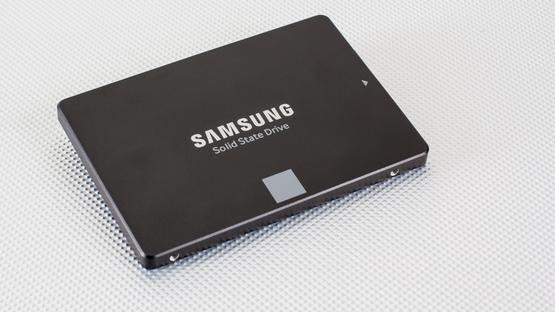
The Samsung 850 EVO is one of the best internal SSDs on the market. Using its V-NAND technology (vertical layering of the flash drive) it is able to deliver blistering fast speeds.
The drive is available in 120-, 250-, 500GB, 1- and 2TB storage capacities. When our sister publication PC Advisor reviewed the drive, it cost £109.04 for the 500GB drive. Prices do fluctuate, so make sure you look out for deals.
When benchmarked through CrystalDiskMark we found the internal SSD to perform very well, with sequential read speeds of 524.4MB/s and write speeds of 512.1MB/s. Its smaller 4K benchmark tests scored impressively with 36.3- read and 106.2MB/s write speeds.
The drive also features AES 256-bit encryption, making it more secure over some other SSDs on the market.
As this is an internal drive, you"ll need to make sure it fits and connects to your Mac. The SSD consumes 4.7W when active and uses only 0.5W whilst being idle.
The drive comes with a five year warranty and has dimensions of 69.85x100x6.8mm.
The SSD is one of the most consistent and fastest drives found in the market today. Installing the internal SSD to an existing Mac system will add a lot of performance over a standard hard disk.
Toshiba Q300 (2016)
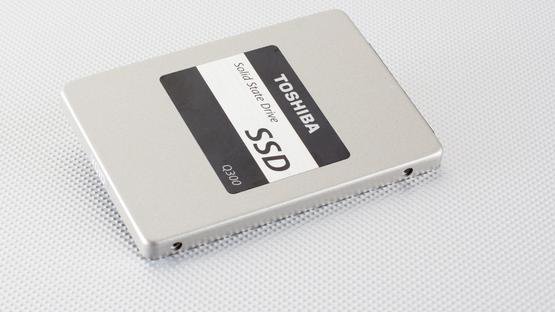
The Toshiba Q300 (2016 version) is an impressive internal SSD, which is able to deliver fast speeds at a very affordable price. Our sister publication PC Advisor reviewed the 480GB storage option at £79.99, making it one of the cheapest drives given its storage size - though prices have risen slightly since.
The Toshiba Q300 (2016) comes in 120-, 240-, 480- and 960GB. The drive runs on Toshiba"s very own 15nm triple-level cell (TLC) flash.
The drive also delivered impressive benchmark results, with its sequential performance hitting 529.3- read and 511.5MB/s write. Its 4K-performance was also performed well versus its competitors, with a read of 29.8- and write of 65.1MB/s.
The drive"s dimensions are 69.85x100x7mm, where it consumes only 3.6W when active and 0.3W whilst idle.
Given its performance and price, the Toshiba Q300 (2016 version) is an inexpensive, fast-performance SSD that will deliver blistering speeds to any compatible Mac.
Samsung Portable SSD T3
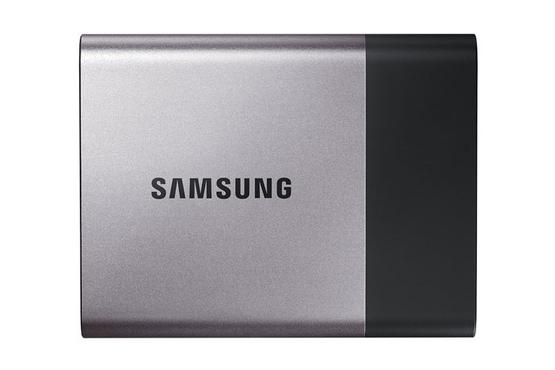
The Samsung Portable SSD T3 is a portable storage drive little bigger than the mSATA card inside, and now with capacity to rival traditional laptop hard disks. It comes in 250GB, 500GB, 1TB and 2TB capacities.
Many consumer gadget fans extol and elevate the virtue of being light in weight and possessing vanishingly small dimensions. And by that measure the Samsung T3 is a winner, measuring just 74x58mm, and 10mm thick. It"s incredibly light too at just 51g.
The software on Mac demands you install an additional kernel extension to complete the unlock stage. This SCSI ATA Translation (SAT) SMART extension, despite the name, does not ultimately provide any readable SMART data for Samsung’s software. It really does look like an unnecessary hoop you must jump through, and an annoying extra kernel extension left widowed in the computer’s file system.
The Samsung Portable SSD.app software provides but one function, to access the drive’s AES 256 encryption. Once the T3 drive has been set up, it does not require any proprietary software to access the data.
Using CrystalDiskMark, we saw maximum sequential transfers of 406MB/s (reads) and 211MB/s (writes). Turning to smaller file speeds, 4kB reads and writes measured 21.9- and 2.3MB/s respectively.
The Samsung Portable SSD T3 2TB is a fast and highly compact flash drive well suited to anyone that needs speedy storage without the noise and bulk of disk-based drives, but it"s pricey at £680 or $950 in the US.
The 500GB version, however, can be found for as little as £150 at Amazon or $245 at Amazon.com. And the 1TB model costs £280 or $445 in the US.
Buffalo MiniStation Thunderbolt
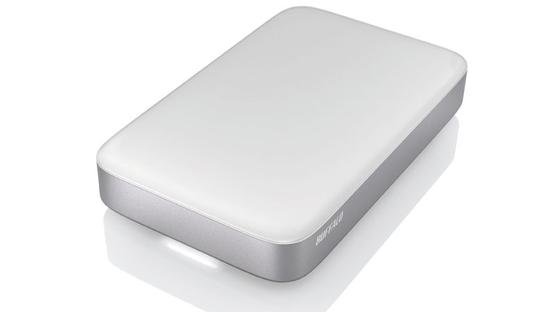
Buffalo Technology"s MiniStation Thunderbolt joins a short list of portable flash drives that accommodate both Thunderbolt and USB 3.0 connections. That adds welcome versatility, enabling connection to Windows PCs with their 5Gb/s USB 3.0 ports, while Mac users can take advantage of the fastest desktop data bus in the business from 10Gb/s Thunderbolt.
It weighs a little under 250g and is sized to accommodate an internal 2.5in SATA SSD. The result is not tiny at 130x81mm, and 24mm thick, but somehow its soft rounded bottom stamped from thin aluminium sheet, and frosted white plastic top, combine to make it rather preternaturally tactile. Inside is a 256GB Crucial M4 SSD.
Tested first over USB 3.0, the Buffalo averaged sequential reads at 401MB/s and provided write speeds far behind at just 258MB/s. While these speeds far exceed laptop disk drives they"re also among the slowest we’ve measured for this capacity of portable flash drive. Turning to small-file transfer speeds from the Buffalo, data up to 1024kB averaged 155MB/s for random reads but just 66MB/s random writes.
Connected via Thunderbolt, the Buffalo drive"s speed dropped to just 391MB/s sequential reads and the same 258MB/s sequential writes as USB 3.0. The small-file test reported random reads down at 146MB/s, and again 66MB/s for random writes.
The real flaw that still underlies Thunderbolt portable drives is underspecified supporting electronics, since power consumption available through the Thunderbolt bus is limited to less than that required with today"s electronic components. This results in transfer speeds of portable Thunderbolt devices that lag behind the nominally slower USB 3.0 protocol.
The Buffalo"s looks and tactility will recommend it to anyone taken by its neat form, but faster and cheaper USB 3.0-only portable drives offer better value.
Transcend StoreJet 500 Portable SSD
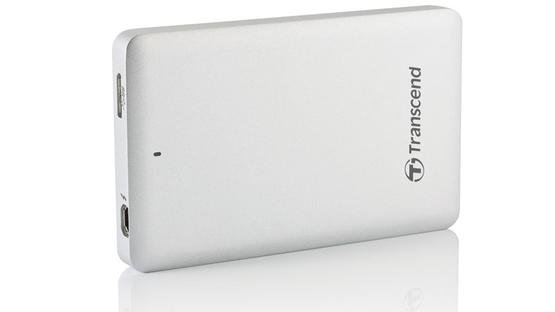
The Transcend StoreJet 500 offers both Thunderbolt and USB 3.0 connectivity, all finished in a smart all-aluminium enclosure that perfectly matches the natural metal finish of the Apple MacBook. At 121x75mm, and 12.5mm thick, it fits neatly into the hand, helped by nicely rounded corners. It feels solid yet weighs only 134g without cables.
On the drive"s top is a small LED which lights blue to show connection, and blinks rapidly during transfers. And on the back edge are the two ports, Micro-USB 3.0 and Thunderbolt.
Using the Thunderbolt connection, the StoreJet 500 was capable of 391MB/s reads and 291MB/s writes in large file sequential transfers. Those are speedy figures compared to hard disk drives that peak at around 100- to 120MB/s, but it also makes this Thunderbolt SSD much slower than the 500+MB/s that modern SATA Revision 3 solid-state drives deliver.
Small file reading and writing performance was good, with the average across 4- to 1024kB files amounting to 134MB/s random reads and 203MB/s random writes.
Turning to the USB 3.0 connection, the StoreJet 500 was capable of 437MB/s sequential reads and 297MB/s sequential writes. The read figure at least is on the edge of what is currently possible with USB 3.0 drives that are now employing the UASP protocol to overcome other limitations in USB 3.0 storage standard, but we would also expect to see sequential write speed closer to 400MB/S than 300MB/s.
Small-file transfers were at a similar level over USB 3.0 as they were with Thunderbolt; giving slightly faster than average for small random reads (144MB/s), and slightly slower than average for random writes (188MB/s).
Like other dual-connection flash drives before it, you’re better off sticking to USB 3.0, making the price premium demanded by such Thunderbolt SSDs a poor investment.
Adata SE730
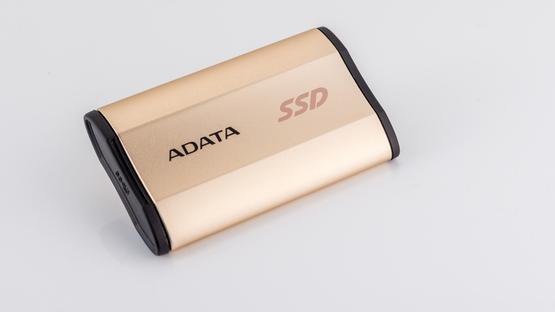
The Adata SE730 is an extremely impressive drive, which performs at blistering speeds whilst remaining affordable.
The drive comes in at £106.44 for a huge 256GB storage space. If that"s not impressive enough, the SE730 has a weight of only 33g, 44x73x12mm size, IP68 certification, a USB 3.1 Gen 2 Type connector and houses the more reliable MLC NAND Flash SSD within its aluminium housing.
We benchmarked the SE730 and found it to be one of the most impressive portable drives we"ve ever come across, with an extremely impressive 380.8- read and 278.5MB/s write speeds in its sequential tests and 19.8- and 38.9MB/s in its smaller 4K file benchmarks.
The SE730 is an easy recommendation for those looking for a truly portable and super-sonic performance from a drive.
SanDisk Extreme 500 Portable SSD

SanDisk is best-known for its range of handy little memory sticks, but it occasionally branches out with other types of storage device, such as its Extreme 500.
We"re not entirely sure where the "500" comes from, but the "Extreme" bit is self-explanatory, as the chunky drive is larger than most solid-state drives but designed to be shock-resistant and vibration-resistant, and to survive temperatures ranging from -4ºF to 158ºF. If you"re after water-resistance, there is the much more expensive 480GB model, which comes with a red edge.
It"s still lighter and more compact than a conventional hard drive, though, measuring just 75.7mm square and 10.7mm thick, and a mere 78.9g in weight. It"s also got a handy hook on one corner so that you can clip it onto a backpack or belt when you"re hiking around the countryside.
We found the drive to perform very well with sequential speeds of 398- read and 203MB/s write speeds. For smaller 4K files it managed 19.8- reads and 3.7MB/s writes.
It"s got a standard USB 3.0 interface, rather than the faster Thunderbolt, but that should still be fast enough for most users and, of course, ensures that the drive is compatible with older Macs and PCs that don’t have Thunderbolt.
The Extreme 500 is also pretty good value for a solid-state drive, starting at around £58.90 for a model with 128GB storage, £72.33 for 240GB, and a competitive £139.26 for the 480GB model. Note: Prices do fluctuate.
Transcend ESD400K SuperSpeed

Keeping up to 1000GB of data close to you is now a doddle - provided you can afford the £400-plus asking price. Transcend’s ESD400K goes up to 1TB size, yet still takes up next to no space and weighs just 56g. But the price of this technology in your pocket is currently around £408 for this capacity.
For smaller budgets and demands, you can also find it in sizes down to 128 GB, which costs around £49.99.
A suedette slip-on cover is included, a useful addition since the soft glossy plastic top can be easily scratched just by carrying in a bag with loose objects.
Like Samsung"s T3, which follows the ESD400K and similar mSATA-based pocket flash drives, the low mass plasticky build actually makes the product too light to use confidently. Especially in this example where the cable weighs almost as much as the drive, and its intractable stiffness means the drive simply won’t lie straight anywhere on the desk.
Get past this minor annoyance, and you have a very speedy piece of storage in the palm of your hand. Like some other models in Transcend"s drive range, the ESD400K includes a One-Touch backup button. Here, it’s so discreetly situated on one edge you could almost miss it. So if you have your own backup regime this superfluous addition shouldn’t even get in your way.
We measured speeds up to 433MB/s in OS X using QuickBench. Sequential write speeds were somewhat lower, perhaps even lower than we now expect with flash technology, but still decent at 370MB/s.
It’s almost too light but the ESD400K is also, just, the cheapest mSATA flash portable drive we’ve seen. For keeping a 1000GB in a tiny and lightweight plastic widget, it comes recommended.
SanDisk iXpand

The iXpand has changed over the years, with the older variant of the flash drive bring a little chunky. The newer variant from SanDisk offers a unique design which is aimed to fit both in a USB 3.0 port and offer iPhone and iPad users additional storage through its lighting port connector.
Like most memory sticks the iXpand has a USB 3.0 interface for connecting to Macs and PCs and a Lightning interface for iOS devices. Through the iXpand drive app you"ll be able to transfer photos and videos on to the iXpand in order to save space on your iOS devices.
It’s available with up to 128GB of storage, so it can handle even the largest video files that you may have on your iPhone or iPad. It also comes in 16-, 32- and 64GB variants.
The drive measures 59x17x13mm in size. You will need iOS 8.2 or above in order to use the device with your iPhone or iPad.
Freecom Tablet Mini SSD

Memory sticks are cheap and easy to carry around, but they"re generally not very fast. If you need a really portable storage device that provides better performance then Freecom’s pocket-sized mSSD is a great choice.
The mSSD measures just 9mm thick, 35mm wide and 80mm long, and weighs only 29g, so you can slip it into your pocket or into a case with your MacBook with no trouble at all. The aluminium casing looks nice and smart alongside your MacBook, and is sturdy enough to cope with a bit of rough treatment when you’re out and about.
The Freecom mSSD is a very lightweight portable drive. It has a metal case made from stamped aluminium with a brushed finish. The company name is printed on the top surface, and the capacity marked on one edge.
There is no protective carry case included, which is disappointing, especially since its sharp edges created scratches on other plastic items in our laptop bag’s pocket.
We tested the £83.99 128GB version - that"s the same size as the SSD used in many MacBook models, so you can do a complete Time Machine backup and still carry it around in your pocket - and it"s also available with 256GB. That bumps the price up to £199.99: still not bad compared to some of the other SSD drives currently available.
In sequential read speeds, the mSSD was found to measure at the limit of what"s now possible from USB 3.0 drives, although its sequential write performance was much lower. In this case that’s probably because 128GB SSDs have slower write speed due to reduced parallelism compared to 256+GB solid-state drives.
Tested with 2- to 10MB files it averaged 439MB/s sequential reads and 148MB/s sequential writes. Small-file performance was good, if rather slower than the leading flash drives in this category. Random reads from 4- to 1024kB averaged 152MB/s while random writes averaged just 89MB/s.
The mSSD is a relatively inexpensive portable flash drive. It’s as quick as any other USB 3.0 flash drive when reading large files, but the 128GB option proved much slower at file writing. Nevertheless as a compact storage device, it will serve better than a regular USB thumbdrive.
It’s a shame that the mSSD only has a standard USB 3.0 interface, but Thunderbolt would add quite a bit to the cost, and USB 3.0 should still be fast enough for your routine Time Machine backups.
No comments:
Post a Comment